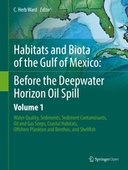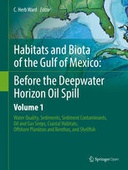Explore

Habitats and Biota of the Gulf of Mexico: Before the Deepwater Horizon Oil Spill: Volume 1: Water Quality, Sediments, Sediment Contaminants, Oil and Gas Seeps, Coastal Habitats, Offshore Plankton and Benthos, and Shellfish
The Gulf of Mexico is an open and dynamic marine ecosystem rich in natural resources but heavily impacted by human activities, including agricultural, industrial, commercial and coastal development. Nutrients and pollutants from coastal communities and dozens of rivers flow into the Gulf, including material from the Mississippi River watershed, which drains over one third of continental United States. The Gulf of Mexico has been continuously exposed to petroleum hydrocarbons for millions of years from natural oil and gas seeps on the sea floor, and more recently from oil drilling and production activities located in the water near and far from shore. Major accidental oil spills in the Gulf are infrequent; two of the most significant include the Ixtoc I blowout in the Bay of Campeche in 1979 and the Deepwater Horizon Oil Spill in 2010. Unfortunately, baseline assessments of the status of habitats and biota in the Gulf of Mexico before these spills either were not available, or the data had not been systematically compiled in a way that would help scientists assess the potential short-term and long-term effects of such events.
This 2-volume series compiles and summarizes thousands of data sets showing the status of habitats and biota in the Gulf of Mexico before the Deepwater Horizon Oil Spill that began on April 20, 2010. Volume 1 begins with an overview of the following 13 chapters and focuses on the big picture rather than the details of habitat quality and biota.
Volume 1 covers:
• Water and sediment quality and contaminants, to provide perspective on environmental conditions in the Gulf.
• Natural oil and gas seeps in the Gulf of Mexico, to identify natural sources of exposure to petroleum hydrocarbons.
• Coastal habitats, including flora and fauna and coastal geology.
• Offshore benthos and plankton, with an analysis of current knowledge on energy capture and energy flows in the Gulf.
• Shellfish and finfish resources that provide the basis for commercial and recreational fisheries.
Chapters in these volumes have been peer reviewed by scientific experts in the subject areas covered. Hopefully, the collection and analysis of such data for the Gulf of Mexico will be continued and sponsored by responsible federal and state agencies with the frequency needed to accurately assess potential damage to natural resources from ecologically harmful events that may occur in the future.
This book is included in DOAB.
Why read this book? Have your say.
You must be logged in to comment.
Rights Information
Are you the author or publisher of this work? If so, you can claim it as yours by registering as an Unglue.it rights holder.Downloads
- 32 - pdf (None) at Google Books.
- 70 - pdf (CC BY-NC) at OAPEN Library.
- 138 - mobi (CC BY-NC) at Unglue.it.
- 197 - pdf (CC BY-NC) at Unglue.it.
- 198 - epub (CC BY-NC) at Unglue.it.
Keywords
- Economics
- Economics, finance, business & management
- Environmental economics
- Environmental management
- freshwater sciences
- Gulf of Mexico
- marine
- marine endangered species
- Marine Habitats
- marine sediment and water quality
- marine wildlife
- oil seeps in Gulf of Mexico
- thema EDItEUR::K Economics, Finance, Business and Management::KC Economics::KCV Economics of specific sectors::KCVG Environmental economics
Links
DOI: 10.1007/978-1-4939-3447-8web: https://link.springer.com/book/10.1007/978-1-4939-3447-8
Editions


